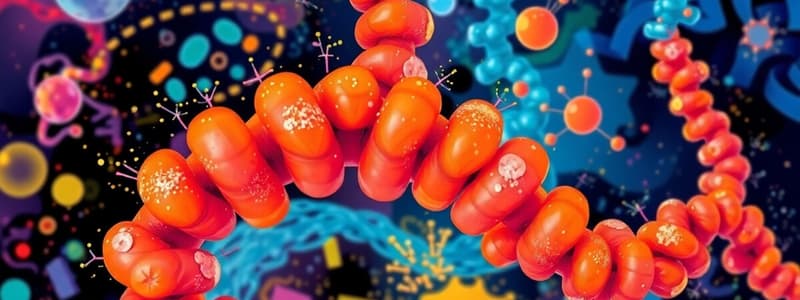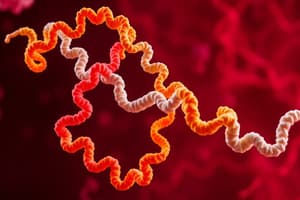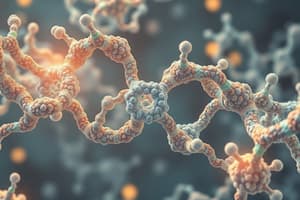Podcast
Questions and Answers
What happens to the reaction rate as substrate concentration increases?
What happens to the reaction rate as substrate concentration increases?
- The reaction rate remains the same.
- The reaction rate decreases.
- The reaction rate fluctuates randomly.
- The reaction rate increases until saturation is reached. (correct)
What occurs when an enzyme reaches its saturation point?
What occurs when an enzyme reaches its saturation point?
- The reaction speed increases indefinitely.
- The enzyme becomes inactive.
- Additional enzymes are created.
- All active sites of the enzyme are occupied. (correct)
How does temperature affect enzyme activity?
How does temperature affect enzyme activity?
- Temperature has no effect on enzyme reactions.
- Enzymes work best at their highest possible temperatures.
- Increasing temperature always decreases reaction rates.
- Moderate increases in temperature can enhance reaction rates until denaturation occurs. (correct)
What might cause an enzyme to denature?
What might cause an enzyme to denature?
Which of the following best describes the effect of pH on enzymes?
Which of the following best describes the effect of pH on enzymes?
What is an example of an enzyme mentioned that breaks down hydrogen peroxide?
What is an example of an enzyme mentioned that breaks down hydrogen peroxide?
What is the optimal temperature for human enzymes?
What is the optimal temperature for human enzymes?
How does increasing enzyme concentration affect reaction rates?
How does increasing enzyme concentration affect reaction rates?
What role do enzymes play in biochemical reactions?
What role do enzymes play in biochemical reactions?
What is the function of an enzyme's active site?
What is the function of an enzyme's active site?
How do enzymes reduce the activation energy of a reaction?
How do enzymes reduce the activation energy of a reaction?
Which of the following describes enzyme specificity?
Which of the following describes enzyme specificity?
Which factor could decrease enzyme activity in a reaction?
Which factor could decrease enzyme activity in a reaction?
What is the end result of an enzyme-substrate complex formation?
What is the end result of an enzyme-substrate complex formation?
What is likely to happen when substrate concentrations are low?
What is likely to happen when substrate concentrations are low?
Which of the following is a true statement about proteases?
Which of the following is a true statement about proteases?
What is the primary role of enzymes in biochemical reactions?
What is the primary role of enzymes in biochemical reactions?
Which factor does NOT influence enzyme activity?
Which factor does NOT influence enzyme activity?
What forms when a substrate binds to an enzyme's active site?
What forms when a substrate binds to an enzyme's active site?
What is an example of an enzyme that catalyzes the hydrolysis of starch?
What is an example of an enzyme that catalyzes the hydrolysis of starch?
How do cofactors and coenzymes affect enzyme activity?
How do cofactors and coenzymes affect enzyme activity?
What best describes the shape of an enzyme's active site?
What best describes the shape of an enzyme's active site?
What mechanism do enzymes use to facilitate biochemical reactions?
What mechanism do enzymes use to facilitate biochemical reactions?
Which type of enzyme is responsible for breaking peptide bonds in proteins?
Which type of enzyme is responsible for breaking peptide bonds in proteins?
What is the main reason that increasing substrate concentration raises the reaction rate?
What is the main reason that increasing substrate concentration raises the reaction rate?
What does reaching the saturation point in enzyme activity indicate?
What does reaching the saturation point in enzyme activity indicate?
How does temperature affect enzyme activity until the optimal temperature is reached?
How does temperature affect enzyme activity until the optimal temperature is reached?
What is the outcome for enzymes if the temperature exceeds their optimal range?
What is the outcome for enzymes if the temperature exceeds their optimal range?
Which of the following describes the relationship between pH and enzyme activity?
Which of the following describes the relationship between pH and enzyme activity?
What can happen to an enzyme when the pH is significantly outside its optimal range?
What can happen to an enzyme when the pH is significantly outside its optimal range?
Why does increasing enzyme concentration only increase reaction rate when there's excess substrate?
Why does increasing enzyme concentration only increase reaction rate when there's excess substrate?
What role does catalase play in living organisms?
What role does catalase play in living organisms?
How do ribozymes differ from typical enzymes?
How do ribozymes differ from typical enzymes?
What characterizes the unique shape of an enzyme's active site?
What characterizes the unique shape of an enzyme's active site?
What is the implication of an enzyme reaching its saturation point regarding substrate molecules?
What is the implication of an enzyme reaching its saturation point regarding substrate molecules?
Which factor would most likely lead to an increase in enzyme activity?
Which factor would most likely lead to an increase in enzyme activity?
Which statement accurately describes the effect of temperature on enzymes?
Which statement accurately describes the effect of temperature on enzymes?
What type of reactions do proteases specifically catalyze?
What type of reactions do proteases specifically catalyze?
What is likely to occur when an enzyme's activity is low due to low substrate concentration?
What is likely to occur when an enzyme's activity is low due to low substrate concentration?
Which of the following factors would most likely lower the reaction rate of an enzyme-catalyzed reaction?
Which of the following factors would most likely lower the reaction rate of an enzyme-catalyzed reaction?
What effect does reaching the saturation point of enzymes have on reaction rates?
What effect does reaching the saturation point of enzymes have on reaction rates?
What is the consequence of raising enzymatic temperature beyond its optimal point?
What is the consequence of raising enzymatic temperature beyond its optimal point?
Which factor has the least impact on enzyme activity at concentrations above saturation?
Which factor has the least impact on enzyme activity at concentrations above saturation?
How does a change in pH affect an enzyme's active site?
How does a change in pH affect an enzyme's active site?
Why is catalase important in living organisms?
Why is catalase important in living organisms?
What will happen to enzyme activity if both the enzyme and substrate concentrations are increased beyond optimal levels?
What will happen to enzyme activity if both the enzyme and substrate concentrations are increased beyond optimal levels?
What typically happens to enzyme function at extreme temperatures?
What typically happens to enzyme function at extreme temperatures?
What defines an enzyme's 'optimal temperature'?
What defines an enzyme's 'optimal temperature'?
Flashcards
Enzyme
Enzyme
A biological catalyst that speeds up chemical reactions in living organisms without being consumed in the process.
Enzyme specificity
Enzyme specificity
Each enzyme typically acts on a specific substrate or type of substrate, ensuring reactions are precisely controlled.
Active site
Active site
The specific region on an enzyme where a substrate binds and the chemical reaction occurs.
Substrate
Substrate
Signup and view all the flashcards
Enzyme-substrate complex
Enzyme-substrate complex
Signup and view all the flashcards
Activation energy
Activation energy
Signup and view all the flashcards
Substrate concentration
Substrate concentration
Signup and view all the flashcards
Enzyme concentration
Enzyme concentration
Signup and view all the flashcards
Enzyme Saturation
Enzyme Saturation
Signup and view all the flashcards
Enzyme Concentration Impact
Enzyme Concentration Impact
Signup and view all the flashcards
Optimal Temperature
Optimal Temperature
Signup and view all the flashcards
Temperature Denaturation
Temperature Denaturation
Signup and view all the flashcards
Optimal pH
Optimal pH
Signup and view all the flashcards
pH Denaturation
pH Denaturation
Signup and view all the flashcards
Substrate Concentration Effect
Substrate Concentration Effect
Signup and view all the flashcards
Catalase Role
Catalase Role
Signup and view all the flashcards
Saturation Point
Saturation Point
Signup and view all the flashcards
What happens to the reaction rate when substrate concentration increases?
What happens to the reaction rate when substrate concentration increases?
Signup and view all the flashcards
What happens to the reaction rate when enzyme concentration increases?
What happens to the reaction rate when enzyme concentration increases?
Signup and view all the flashcards
How does pH affect enzyme function?
How does pH affect enzyme function?
Signup and view all the flashcards
What do enzymes do?
What do enzymes do?
Signup and view all the flashcards
What are enzymes made of?
What are enzymes made of?
Signup and view all the flashcards
How do enzymes work?
How do enzymes work?
Signup and view all the flashcards
What are the factors affecting enzyme activity?
What are the factors affecting enzyme activity?
Signup and view all the flashcards
How does enzyme concentration affect reaction rate?
How does enzyme concentration affect reaction rate?
Signup and view all the flashcards
What happens to enzyme activity at high temperatures?
What happens to enzyme activity at high temperatures?
Signup and view all the flashcards
What is the optimal pH for enzymes?
What is the optimal pH for enzymes?
Signup and view all the flashcards
What happens to enzyme activity when substrate concentration is low?
What happens to enzyme activity when substrate concentration is low?
Signup and view all the flashcards
Enzyme Role
Enzyme Role
Signup and view all the flashcards
Enzyme Structure
Enzyme Structure
Signup and view all the flashcards
Lowering Activation Energy
Lowering Activation Energy
Signup and view all the flashcards
Optimal Temperature for Enzymes
Optimal Temperature for Enzymes
Signup and view all the flashcards
Optimal pH for Enzymes
Optimal pH for Enzymes
Signup and view all the flashcards
What happens to the reaction rate as substrate concentration increases?
What happens to the reaction rate as substrate concentration increases?
Signup and view all the flashcards
Enzyme Concentration Effect
Enzyme Concentration Effect
Signup and view all the flashcards
pH and Enzyme Function
pH and Enzyme Function
Signup and view all the flashcards
How does Catalase work?
How does Catalase work?
Signup and view all the flashcards
Study Notes
Experiment 4: Enzyme Activity
- Enzymes are biological catalysts that speed up chemical reactions in living organisms without being consumed.
- Enzymes are crucial for maintaining life, regulating virtually every biochemical reaction in cells.
- Enzymes are proteins, typically made of long amino acid chains folded into complex 3D structures; some are RNA-based (ribozymes).
- Enzymes are often named by adding "-ase" to the name of the reaction or substrate they are involved with.
- Example: Dehydrogenase removes hydrogen.
Enzyme Specificity
- Each enzyme acts on a specific substrate or type of substrate, ensuring reactions are precisely controlled.
- Specificity is due to the unique shape and chemical properties of the active site, which only accepts certain substrates.
Enzyme Parts
- Active Site: A specific region on the enzyme where the substrate binds and the chemical reaction occurs.
- Substrate: The molecule(s) that the enzyme acts upon, not part of the enzyme itself.
- Enzyme-Substrate Complex: When a substrate binds to the active site, it forms this complex, undergoing a chemical transformation.
- Products: The end result of the reaction.
Function and Mechanism
- Enzymes work by lowering the activation energy of a reaction.
- Activation energy is the initial energy needed for a reaction to proceed.
- By reducing this energy, enzymes make reactions easier and faster.
Example Enzymes
- Proteases: Break peptide bonds in proteins.
- Amylases: Catalyze the hydrolysis of starch.
- Catalase: Breaks down hydrogen peroxide (H₂O₂).
Factors Affecting Enzyme Activity
- Substrate concentration
- Enzyme concentration
- Temperature
- pH
- Presence of cofactors and coenzymes
- Presence of inhibitors or activators
Concentration of Enzymes and Substrates
- Increasing substrate or enzyme concentration can influence reaction rates up to reaching a saturation point.
- At low substrate concentrations, the reaction rate is low. As concentration increases, reaction rate increases. At higher substrate concentrations, the rate of reaction plateaus as the maximum possible number of collisions between substrate and active site of enzyme are occurring therefore adding more substrate won't increase the reaction rate (saturation point).
- Increasing enzyme concentration increases reaction rate, as there will be more active sites available for substrates until it reaches a saturation point
Temperature
- Each enzyme functions most efficiently at an optimal temperature, typically around the body temperature of the organism. (e.g., 37°C for humans).
- Increasing the temperature initially increases the reaction rate as molecular movement increases, leading to more frequent substrate-enzyme collisions.
- If temperature rises too high, enzymes denature losing their structure and function because the bonds holding the enzyme's structure together are disrupted.
pH
- Enzymes have an optimal pH at which they work best.
- Optimal pH varies across enzymes depending on their environment (e.g., pepsin in acidic conditions, trypsin in neutral or basic conditions).
- Changes in pH can disrupt ionic bonds and hydrogen bonds in the enzyme, changing its shape and the active site. Extreme pH values can cause enzyme denaturation.
The Practical Work: Catalase
- Catalase is an enzyme found in nearly all living organisms that breaks down hydrogen peroxide (H₂O₂) into water (H₂O) and oxygen (O₂).
- In experiments, potatoes are often used as the source of catalase.
- Experiments to investigate the effects of variables such as substrate concentration, temperature, and pH, on the activity of catalase can be conducted.
Things to Note
- Hydrogen peroxide (H₂O₂) is a toxic chemical that can burn skin.
- Immediately rinse any spills with water.
- Wash hands before leaving the lab.
Studying That Suits You
Use AI to generate personalized quizzes and flashcards to suit your learning preferences.




